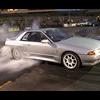Rb20det Engine Parts
Announcements
-
Similar Content
-
Latest Posts
-
By DraftySquash · Posted
Good news!!! Changed the O ring today and I’ve got the “pssshhhh” back when I open the fuel cap 😂🙌🏼🙌🏼 It was 100% the O ring because that bloody thing was inside the fuel tank 😂😂😂😂😂 Fitting new fuel pump was a pain as always since the DW is a bit longer than stock. But she’s running!!! ❤️ -
PWM quite literally just chops the ful 12V voltage on and off at whatever duty cycle you're running it at. If you're running it 100%, then it is on full voltage all the time, same as if there was no PWM. If you run it at 50% duty cycle, it is only seeing the full 12V half of the time. This is broadly equivalent to running it at 6V. But the crucial difference is that motors (and a lot of other loads) don't like being powered at low volts. They will either fail to start rotating, or draw a shit ton of current, or other undesirable things. But if you give them the full volt, and then a short period of no volts, and then some more full volts, then the times when they are seeing power they are seeing all the voltage, and they are happy. But you get the performance out of them as if they were only seeing that fraction of the full voltage. It is not really easy to answer your question about what flow you will get out of it at 50% duty cycle. I can tell you that it is not as simple as you think. For a start, that 460 L/h pump is not going to flow 460 when you're on boost. When you're on boost you will be somewhere down the sloping part of that red line. If you have 15 psi of boost, then the pump can only deliver about 95 gal/h, which is <380L/h. So your simple 50% on 460 = 230 wasn't going to work anyway. But also, it won't deliver 50% of 380 either, because when you devolt or PWM trim th epower being fed to the pump, it is not able to deliver flow or pressure in the same way. 50% duty cycle will probably produce <50% of the full voltage flow. The way to find out what duty cycle you need to run it at at low load (ie, at idle) is to idle it and turn the DC down until you start to lose fuel pressure, then turn it back up above that with some extra for safety. And then you do the same thing at full load, in case it doesn't need anywhere near 100% DC. And if you're careful/caution/prudent, you will also do it at a couple of loads in between so you can shape the DC map against load. It might not be linear between the two end points.
-
Man that dinner was such a long time ago....2010! I would only replace the rubber coolant lines with silicone these days; cheap, readily available and will last for ever. You will need new hose clamps though eg https://justjap.com/products/cooling-pro-silicone-engine-heater-hose-set-black-nissan-r32-gtr-rb26dett
-
I wouldn't look too hard at what they did with the R32 GTR in endurance racing in Australia... Lots of things weren't actually available from the factory in the way those cars ran them... Japan also followed what Fred Gibson was doing here with some of there endurance cars in Japan... Australia is also the reason for things like the Brembo brakes, and the change in the gearbox... And quite a few other tricks they used to pull. There's a few other SAU peeps still on these forums that will have heard the stories direct from Alan Heaphy, Fred Gibson, and Jim Richards when we were lucky enough to have a great dinner with them
-
By joshuaho96 · Posted
For all the talk of "these parts are junk" I generally recommend OEM because it's really not as bad as claimed. I have never seen or heard of a case like the N63 where the oil returns completely clog with coked oil for example in ~10 years or less. Would it be nice if it were a straighter path? I guess, but most modern cars use a scavenge pump instead of a pure gravity return. Also the factory lines that would be relatively simple to convert to braided are generally speaking hardlines from the factory. I would consider braided line to be a regression, not an improvement. It's also been engineered such that all the hardlines have appropriate strain relief where needed. There's absolutely room for improvement, for example the HKS advantage heritage intake piping shows just how much can be done to make the turbos fight each other less in OEM twin turbo configuration and reduce compressor surge but it's rarely a simple/straightforward process. I recommend looking at what the group A/N1 cars did, generally speaking the changes they made were necessary and proven in endurance racing.
-





Recommended Posts
Create an account or sign in to comment
You need to be a member in order to leave a comment
Create an account
Sign up for a new account in our community. It's easy!
Register a new accountSign in
Already have an account? Sign in here.
Sign In Now